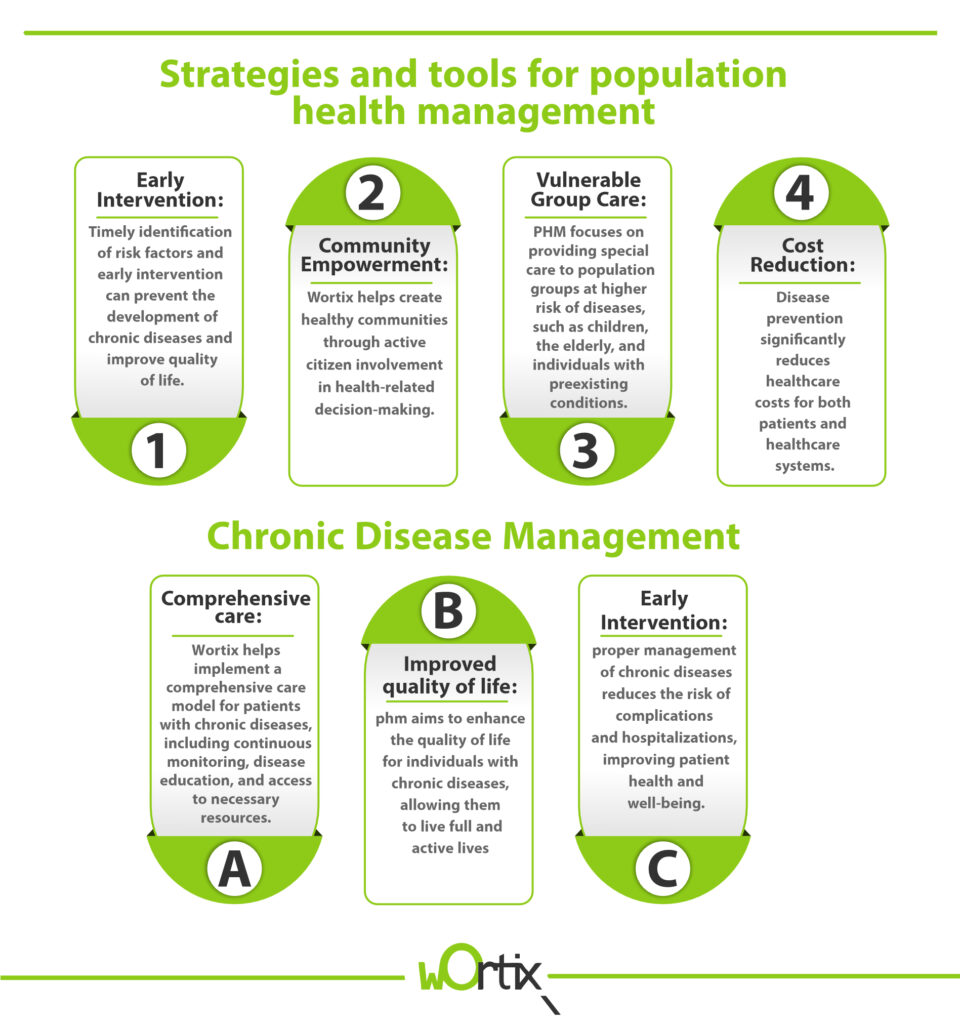Population Health Management (PHM) has become a fundamental paradigm for improving the health and well-being of communities. This comprehensive approach extends beyond individual medical care, focusing on the social, economic, and environmental determinants influencing population health.
In this article, we’ll introduce three key pillars of PHM and how Wortix, the global healthcare network, can assist in implementing effective strategies in your healthcare center, pharmacy, or healthcare network.
Understanding population health management
Population Health Management is a comprehensive approach that focuses on the health and well-being of an entire community, rather than solely on individual medical care. It encompasses identifying, monitoring, and addressing the factors affecting population health to enhance long-term health outcomes and reduce associated healthcare costs. It integrates prevention, health promotion, early intervention, and chronic disease management strategies to proactively and effectively address health needs.
Population health management also involves collaboration among various healthcare system stakeholders, including physicians, healthcare centers, pharmacies, and healthcare networks, to provide coordinated and patient-centered care.
Importance of population health management
In today’s complex healthcare landscape, Population Health Management emerges as a fundamental pillar for ensuring quality, efficiency, and equity in healthcare services. This comprehensive approach focuses on improving the health and well-being of entire communities beyond individual disease treatment. For physicians, healthcare centers, pharmacies, and healthcare networks, effective Population Health Management becomes an essential tool for delivering top-notch healthcare.
Key benefits of adopting a Population Health Management approach include:
Improved Health Outcomes: By identifying and addressing population health factors and needs, Population Health Management can prevent diseases, promote early detection, and enhance chronic disease management, resulting in better quality of life and reduced long-term health complications.
Healthcare Efficiency: PHM enables resource optimization and ensures more efficient healthcare delivery. By focusing on prevention and coordinated care, unnecessary hospitalizations can be avoided, and costs associated with treating advanced diseases can be reduced.
Personalized Care: Understanding the unique characteristics of the served population allows for tailored healthcare and pharmacy services to meet specific patient needs. This includes considering socioeconomic, cultural, and demographic factors, improving accessibility, and treatment adherence.
Strategies and tools for population health management
PHM encompasses various strategies and tools aimed at identifying, monitoring, and addressing community health needs. From collecting and analyzing demographic and epidemiological data to implementing prevention and health promotion programs, these actions are essential for improving long-term health outcomes.
Technology plays a crucial role in this process, with platforms like Wortix offering comprehensive solutions for effective PHM. With advanced data analysis, patient tracking, and care coordination functionalities, Wortix enables healthcare professionals to identify health trends, intervene proactively, and improve community health.
Early Intervention: Timely identification of risk factors and early intervention can prevent the development of chronic diseases and improve quality of life.
Community Empowerment: Wortix helps create healthy communities through active citizen involvement in health-related decision-making.
Vulnerable Group Care: PHM focuses on providing special care to population groups at higher risk of diseases, such as children, the elderly, and individuals with preexisting conditions.
Cost Reduction: Disease prevention significantly reduces healthcare costs for both patients and healthcare systems.
Chronic Disease Management:
Comprehensive care: Wortix helps implement a comprehensive care model for patients with chronic diseases, including continuous monitoring, disease education, and access to necessary resources.
Improved quality of life: PHM aims to enhance the quality of life for individuals with chronic diseases, allowing them to live full and active lives.
Complication reduction: proper management of chronic diseases reduces the risk of complications and hospitalizations, improving patient health and well-being.

Benefits and outcomes of effective population health management
Effective PHM not only benefits individual patients but also has a positive impact on the healthcare system as a whole. By focusing on prevention, monitoring, and early intervention, this strategy leads to a decrease in preventable hospitalizations, reduced healthcare costs, and improved community health. Additionally, by promoting collaboration among different healthcare stakeholders, such as physicians, healthcare centers, pharmacies, and healthcare networks, a more integrated and patient-centered care environment is created. Ultimately, effective PHM benefits healthcare providers and enhances the health and well-being of the entire community they serve.
A Comprehensive Approach
Population Health Management represents a necessary evolution in modern healthcare. By adopting this comprehensive approach and leveraging available technological tools, physicians, healthcare centers, pharmacies, and healthcare networks can improve health outcomes, reduce costs, and provide quality healthcare to their communities.
Wortix offers the tools and support needed to implement effective PHM strategies in your healthcare center, pharmacy, or healthcare network.
Are you ready to transform your community’s health?
Contact Wortix today and discover how PHM can help improve the health and well-being of the population you serve.
Remember: PHM is an investment in the future of your community, with tangible benefits for health, quality of life, and the economy.
Don’t miss this opportunity to be part of the change!
Sources Consulted:
https://www.who.int/europe/publications/i/item/WHO-EURO-2023-7497-47264-69316